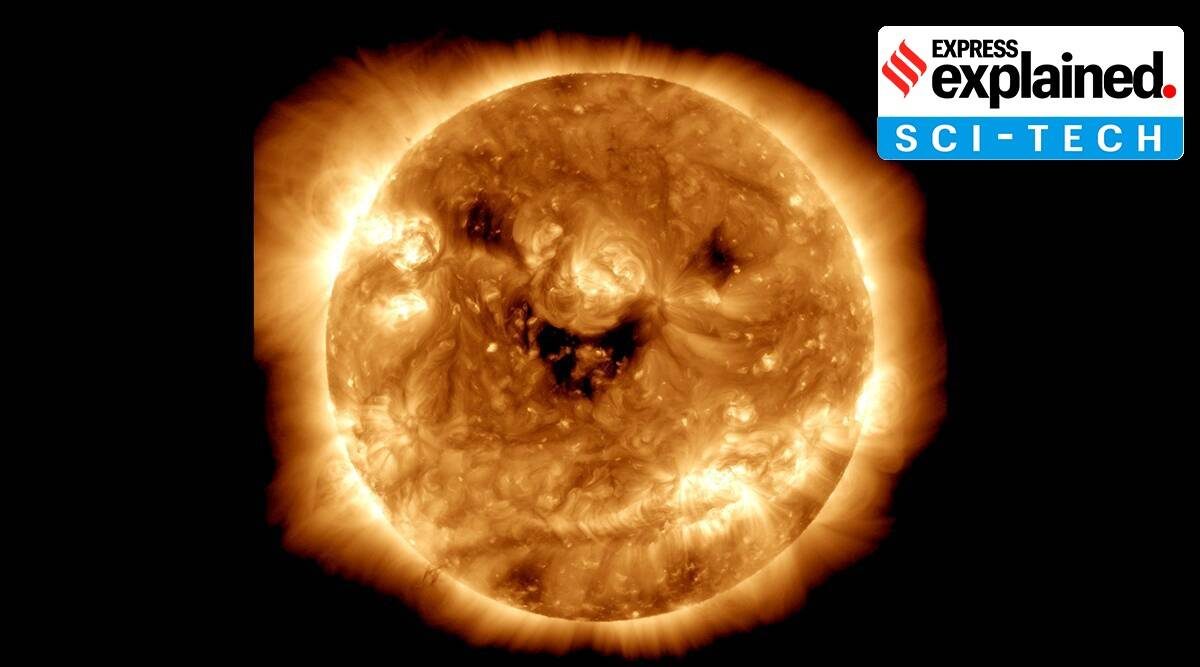Important Facts For Prelims
Coronal Holes
- 03 Nov 2022
- 6 min read
Why in News?
Recently, NASA captured an image having dark patches on the sun’s surface resembling eyes and a smile.
- These patches are called ‘Coronal holes’, which can be seen in ultraviolet light but are typically invisible to our eyes.
What are Coronal Holes?
- About:
- These are regions on the sun’s surface from where fast solar wind gushes out into space.
- In these regions, the magnetic field is open to interplanetary space, sending solar material out in a high-speed stream of solar wind i.e. geomagnetic storm.
- They have lower temperatures and appear much darker than their surroundings as they contain little solar material.
- Coronal holes can last between a few weeks to months.
- The holes are not a unique phenomenon, appearing throughout the sun’s approximately 11-year solar cycle.
- They can last much longer during solar minimum, a period of time when activity on the Sun is substantially diminished.
- These are regions on the sun’s surface from where fast solar wind gushes out into space.
- Significance:
- Coronal Holes are important in understanding the space environment around the earth through which our technology and astronauts’ travel.
What is a Geomagnetic Storm?
- Geomagnetic storm is a solar storm that occurs during the release of magnetic energy associated with sunspots (‘dark’ regions on the Sun that are cooler than the surrounding photosphere - the lowest layer of the solar atmosphere), and can last for a few minutes or hours.
- It is a major disturbance of Earth's magnetosphere that occurs when there is a very efficient exchange of energy from the solar wind into the space environment surrounding Earth.
- The magnetosphere shields our home planet from harmful solar and cosmic particle radiation, as well as erosion of the atmosphere by the solar wind – the constant flow of charged particles streaming off the Sun.
- These storms result from variations in the solar wind that produce major changes in the currents, plasmas, and fields in Earth’s magnetosphere.
- The solar wind conditions that are effective for creating geomagnetic storms are sustained (for several to many hours) periods of high-speed solar wind, and most importantly, a southward directed solar wind magnetic field (opposite the direction of Earth’s field) at the dayside of the magnetosphere.
- This condition is effective for transferring energy from the solar wind into Earth’s magnetosphere.
- The largest storms that result from these conditions are associated with solar Coronal Mass Ejections (CMEs) where a billion tons or so of plasma from the sun, with its embedded magnetic field, arrives at Earth.
- CMEs are large ejections of plasma and magnetic fields that originate from the Sun's corona (outermost layer).
UPSC Civil Services Examination Previous Year Question:
Q. If a major solar storm (solar flare) reaches the Earth, which of the following are the possible effects on the Earth? (2022)
- GPS and navigation systems could fail.
- Tsunamis could occur at equatorial regions.
- Power grids could be damaged.
- Intense auroras could occur over much of the Earth.
- Forest fires could take place over much of the planet.
- Orbits of the satellites could be disturbed.
- Shortwave radio communication of the aircraft flying over polar regions could be interrupted.
Select the correct answer using the code given below:
(a) 1, 2, 4 and 5 only
(b) 2, 3, 5, 6 and 7 only
(c) 1, 3, 4, 6 and 7 only
(d) 1, 2, 3, 4, 5, 6 and 7
Ans: (c)
Exp:
- Solar flares are powerful bursts of energy.
- The storms can often be observed as beautiful aurorae in our night sky, but they can also cause major disturbances in Earth’s power grids and navigation systems.
- A massive solar flare erupted from the Sun's surface, disrupting radio waves, telecommunication networks, and power systems by triggering an intense magnetic storm.
- Scientists have found evidence of an extreme solar 'tsunami' deep within the Earth's ice through analyses of ice cores from Greenland and Antarctica.
- A magnetic dam is formed which is storing a big mass of plasma. At the end of a solar cycle, this magnetic dam can break, releasing huge amounts of plasma cascading like a tsunami towards the poles.
- Therefore, statements 1, 3, 4, 6 & 7 are correct. Hence option (c) is correct.





